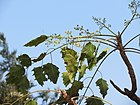Note: This is a project under development. The articles on this wiki are just being initiated and broadly incomplete. You can Help creating new pages.
Ailanthus excelsa - Aralu, Indian tree of heaven
Ailanthus excelsa commonly known as tree of heaven, is a large deciduous tree found in India and Sri Lanka. In Tamil, it is also known as Pi-Nari Maram due to its disagreeable odour.There are many related species in Ailanthus.
Contents
- 1 Uses
- 2 Parts Used
- 3 Chemical Composition
- 4 Common names
- 5 Properties
- 6 Habit
- 7 Identification
- 8 List of Ayurvedic medicine in which the herb is used
- 9 Where to get the saplings
- 10 Mode of Propagation
- 11 How to plant/cultivate
- 12 Commonly seen growing in areas
- 13 Photo Gallery
- 14 References
- 15 External Links
Uses
Dropsy, Sore throat, Chronic dysentery, Asthama, Swellings, Haemorrhoid, Jaundice, Cold, Cough, Catarrh, Anorexia, Flatulence, Abdominal discomfort, Eczema, Dental caries, Bleeding guns, Fever, Eye diseases, Piles, Migraines[1]
Parts Used
Chemical Composition
Ailanthione, glaucarubinone and a mixture of glaucarubol 15-isovalerate and Dehydroglaucarubol, Isovalerate were found to be the compounds responsible for the antitumor and cytotoxic activities of extracts of the root bark of Ailanthus Excelsa.[3]
Common names
| Language | Common name |
|---|---|
| Kannada | Dodabevu, Mahanimba |
| Hindi | Mahanimb, Maharukh |
| Malayalam | Mattipongilyam, Peru, Perumaram |
| Tamil | Perumaram, Perumaruntu |
| Telugu | Pedda, Peddamandu, Peddamanu |
| Marathi | NA |
| Gujarathi | NA |
| Punjabi | NA |
| Kashmiri | NA |
| Sanskrit | Aralu, Araluka, Araluvrksa |
| English | Indian Tree of Heaven, Coramandel ailanto |
Properties
Reference: Dravya - Substance, Rasa - Taste, Guna - Qualities, Veerya - Potency, Vipaka - Post-digesion effect, Karma - Pharmacological activity, Prabhava - Therepeutics.
Dravya
Rasa
Tikta, Kashaya
Guna
Lagu, Ruksha
Veerya
Sheeta
Vipaka
Katu
Karma
Tridoshahaara
Prabhava
Habit
Identification
Leaf
| Kind | Shape | Feature |
|---|---|---|
| Pinnate | Oblong-lanceolate | Leaflets are subopposite, leaf Apex is Acuminate, leaf Base is Oblique and leaf Margin is irregularly toothed-sublobate |
.[4]
Flower
| Type | Size | Color and composition | Stamen | More information |
|---|---|---|---|---|
| Terminal panicles | 0.75 cm. long and 1 cm | Cream coloured | 8-10 | Flowering from January-March |
Fruit
| Type | Size | Mass | Appearance | Seeds | More information |
|---|---|---|---|---|---|
| Samara | 5 x 1.3 cm | Prominently nerved, membranous | Seed 1 | Fruiting from January-March |
Other features
List of Ayurvedic medicine in which the herb is used
Where to get the saplings
Mode of Propagation
How to plant/cultivate
Seeds should be sown in well draining porous media, either in raised nursery beds or polybags. After broadcasting the seeds, they should be covered with a thin layer of sand and kept moist but not excessively. Germination starts 8-14 days later. A plant of the semi-arid to wet tropics, where it is found at elevations up to 900 metres. It grows best in areas where annual daytime temperatures are within the range 20 - 40°c, but can tolerate 4 - 47°c[6]
Commonly seen growing in areas
Field border, Dry Deciduous forest.
Photo Gallery
References
- ↑ Kappathagudda Medicinal Plants of Gadag Book Page no: 49
- ↑ 2.0 2.1 ”Karnataka Medicinal Plants Volume-3” by Dr.M. R. Gurudeva, Page No.597, Published by Divyachandra Prakashana, #6/7, Kaalika Soudha, Balepete cross, Bengaluru
- ↑ Journal Paper from National Library of Medicine - Potential anticancer agents vi. Constituents of Ailanthus excelsa (Simaroubaceae)
- ↑ Morphology
- ↑ Ayurvedic preparations
- ↑ Cultivation Details
External Links
- Ayurvedic Herbs known to be helpful to treat Dropsy
- Ayurvedic Herbs known to be helpful to treat Sore throat
- Ayurvedic Herbs known to be helpful to treat Chronic dysentery
- Ayurvedic Herbs known to be helpful to treat Asthama
- Ayurvedic Herbs known to be helpful to treat Swellings
- Ayurvedic Herbs known to be helpful to treat Haemorrhoid
- Ayurvedic Herbs known to be helpful to treat Jaundice
- Ayurvedic Herbs known to be helpful to treat Cold
- Ayurvedic Herbs known to be helpful to treat Cough
- Ayurvedic Herbs known to be helpful to treat Catarrh
- Ayurvedic Herbs known to be helpful to treat Anorexia
- Ayurvedic Herbs known to be helpful to treat Flatulence
- Ayurvedic Herbs known to be helpful to treat Abdominal discomfort
- Ayurvedic Herbs known to be helpful to treat Eczema
- Ayurvedic Herbs known to be helpful to treat Dental caries
- Ayurvedic Herbs known to be helpful to treat Bleeding guns
- Ayurvedic Herbs known to be helpful to treat Fever
- Ayurvedic Herbs known to be helpful to treat Eye diseases
- Ayurvedic Herbs known to be helpful to treat Piles
- Ayurvedic Herbs known to be helpful to treat Migraines
- Herbs with Leaves used in medicine
- Herbs with Bark used in medicine
- Herbs with Roots used in medicine
- Herbs with common name in Kannada
- Herbs with common name in Hindi
- Herbs with common name in Malayalam
- Herbs with common name in Tamil
- Herbs with common name in Telugu
- Herbs with common name in Sanskrit
- Herbs with common name in English
- Habit - Deciduous tree
- Index of Plants which can be propagated by Seeds
- Herbs that are commonly seen in the region of Field border
- Herbs that are commonly seen in the region of Dry Deciduous forest
- Herbs
- Ayurvedic herbs that don't have seed photos
- Simaroubaceae
- Pages without herbs images





